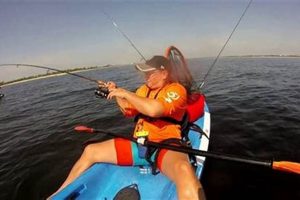Small, human-powered watercraft designed for angling are often augmented with propulsion systems for increased range and easier navigation. These systems typically involve compact, outboard motors suitable for the size and weight of the kayak, allowing anglers to cover more water and conserve energy for fishing. This motorized approach offers a portable and efficient alternative to larger, more resource-intensive fishing boats.
Motorized kayaks offer several advantages for anglers. They provide access to distant fishing grounds with less physical exertion, allowing longer trips and exploration of wider areas. This motorized assistance is particularly beneficial in challenging conditions like strong currents or headwinds. The ability to quickly change location can be crucial for following schools of fish or adjusting to changing weather patterns. Historically, kayak fishing relied solely on paddling, but the integration of engines represents a significant advancement, enhancing both the efficiency and accessibility of this popular sport.
This article will explore the various aspects of choosing and using a motorized kayak for fishing. Topics covered will include different types of propulsion systems, factors to consider when selecting an engine, safety precautions, and the impact of motorization on fishing practices.
Tips for Motorized Kayak Fishing
Successful motorized kayak fishing requires careful planning and execution. These tips offer guidance for maximizing efficiency and safety on the water.
Tip 1: Research Local Regulations: Engine use may be restricted in certain areas. Always check local regulations regarding permitted engine sizes and operational zones before venturing out.
Tip 2: Choose the Right Engine: Consider factors such as kayak weight capacity, desired speed, and fishing environment when selecting an engine. Electric motors offer quiet operation, while gas engines provide greater range.
Tip 3: Proper Battery Management: For electric motors, ensure batteries are fully charged before each trip. Carry a spare battery for extended outings. Understand the range limitations of the battery system.
Tip 4: Practice Maneuvering: Familiarize oneself with the kayak’s handling characteristics with the motor installed. Practice maneuvering in open water before navigating tight spaces or challenging conditions.
Tip 5: Safety First: Always wear a personal flotation device (PFD). Carry essential safety equipment including a whistle, signaling device, and first-aid kit. Inform someone of the intended fishing location and estimated return time.
Tip 6: Respect the Environment: Avoid disturbing wildlife or sensitive habitats. Adhere to leave-no-trace principles and dispose of waste responsibly.
Tip 7: Maintain Equipment: Regular engine maintenance, including oil changes and propeller inspections, is crucial for reliable performance and longevity.
By following these guidelines, anglers can enhance their motorized kayak fishing experience, ensuring both safety and enjoyment on the water. Proper preparation and responsible operation contribute to a positive and productive angling experience.
This information provides a solid foundation for successful motorized kayak fishing. The following section will delve into specific techniques and strategies for various fishing styles.
1. Engine Selection
Engine selection is a critical aspect of configuring a fishing kayak for motorized propulsion. The chosen engine directly impacts performance, range, and the overall fishing experience. Several factors influence this decision, including kayak size and weight capacity, desired speed and range, fishing environment (calm lakes versus flowing rivers), and budgetary constraints. A mismatch between the engine and kayak can lead to instability, reduced efficiency, or even damage to the vessel. For example, an overpowered engine on a small, lightweight kayak can create an unsafe imbalance, while an underpowered engine on a larger, heavier kayak might struggle to achieve satisfactory performance. Choosing the right engine requires a thorough assessment of individual needs and the intended usage scenario.
The type of engineelectric or gasolinefurther complicates the selection process. Electric motors offer quiet operation, making them ideal for stealthy approaches in shallow waters. However, they often have a limited range, determined by battery capacity. Gasoline engines provide greater range and power but require more maintenance and generate noise and exhaust fumes. For instance, an angler targeting fish in a remote area might prioritize the extended range of a gasoline engine, while someone fishing in a noise-sensitive environment might opt for the quiet operation of an electric motor. Practical considerations like ease of transport and storage also play a role in the decision-making process.
Careful engine selection ensures optimal performance and safety. Understanding the interplay between engine characteristics (thrust, horsepower, fuel type) and kayak specifications (length, width, weight capacity) is paramount for a successful motorized kayaking experience. Failure to consider these factors can result in a suboptimal setup, hindering fishing effectiveness and potentially compromising safety. Investing time in research and selection ensures the chosen engine complements the kayak and meets the specific demands of the angler’s fishing style and target environment.
2. Kayak Compatibility
Kayak compatibility is paramount when considering engine integration for fishing. Structural integrity, stability, and weight capacity are crucial factors. A kayak’s design must accommodate the added weight and thrust of a motor without compromising performance or safety. Inadequate compatibility can lead to instability, making the kayak difficult to control, especially in challenging conditions. For example, attaching a powerful engine to a lightweight, narrow kayak designed for paddling could create an unsafe imbalance, increasing the risk of capsizing. Similarly, exceeding the kayak’s weight capacity with an excessively heavy engine and fuel system can submerge the hull, affecting maneuverability and potentially leading to swamping. Careful consideration of kayak specifications alongside engine characteristics is essential.
The placement of the motor mount significantly influences kayak compatibility. Improper mounting can create drag, reduce efficiency, and negatively impact handling. Manufacturers often design specific mounting points on fishing kayaks to optimize engine integration. These designated locations ensure balanced weight distribution and minimize interference with paddling or fishing activities. Modifying a kayak to accommodate a motor mount outside of manufacturer recommendations can compromise structural integrity and void warranties. For instance, drilling holes in unsupported sections of the hull can weaken the kayak, making it susceptible to damage or even failure under stress. Consulting the manufacturer’s guidelines or seeking expert advice is crucial for safe and effective engine integration.
Understanding kayak compatibility is essential for safe and effective motorized fishing. Matching engine specifications to kayak design and adhering to manufacturer recommendations ensure optimal performance and prevent potential hazards. Ignoring compatibility factors can compromise stability, reduce efficiency, and even lead to equipment damage or personal injury. Thorough research and careful planning are vital for a successful and enjoyable motorized kayaking experience.
3. Safety Precautions
Operating a fishing kayak equipped with an engine introduces specific safety considerations beyond those associated with traditional paddling. The added speed and range necessitate heightened awareness and adherence to specific safety protocols. Neglecting these precautions can significantly increase the risk of accidents and injuries. Understanding and implementing appropriate safety measures is crucial for a responsible and enjoyable motorized kayaking experience.
- Personal Flotation Devices (PFDs)
Wearing a properly fitted PFD is paramount. While inherent buoyancy aids in emergency situations, a PFD provides essential flotation, especially if unconsciousness occurs due to impact or cold-water immersion. Different PFD types exist, each offering varying degrees of buoyancy and mobility. Choosing a PFD designed for kayaking ensures comfort and freedom of movement while providing adequate flotation. Neglecting to wear a PFD significantly increases the risk of drowning, especially in challenging conditions or after an unexpected capsize.
- Navigation and Communication
Carrying navigational aids and communication devices is essential, especially in open water or unfamiliar areas. A GPS device or chartplotter helps maintain course and locate fishing spots, while a VHF radio enables communication with other boaters and emergency services. A fully charged mobile phone in a waterproof case serves as a backup communication tool. Knowing how to use these devices effectively is crucial for safe navigation and emergency response. Disorientation or unexpected equipment failure can quickly escalate into a dangerous situation without proper communication and navigation capabilities.
- Engine Safety Procedures
Adhering to engine-specific safety procedures is essential for preventing accidents and equipment malfunctions. Understanding proper starting and stopping procedures, fuel handling guidelines, and emergency shut-off mechanisms is vital. Regular engine maintenance, including inspections of fuel lines, electrical connections, and propeller integrity, minimizes the risk of mechanical failures. Ignoring engine safety protocols can lead to fires, explosions, or loss of control, jeopardizing the safety of the operator and others on the water.
- Weather Awareness
Checking weather forecasts before embarking on a fishing trip is crucial. Sudden changes in weather conditions, such as strong winds, thunderstorms, or fog, can create hazardous situations for kayakers. Knowing the local weather patterns and being prepared for unexpected changes is essential for safe navigation. Ignoring weather warnings or venturing out in unsuitable conditions significantly increases the risk of capsizing, hypothermia, or other weather-related emergencies.
These safety precautions are integral to responsible operation of a fishing kayak equipped with an engine. By adhering to these guidelines and remaining vigilant, anglers can mitigate risks and ensure a safe and enjoyable experience on the water. Prioritizing safety enhances the overall fishing experience and contributes to a culture of responsible boating practices.
4. Fishing Techniques
Engine integration significantly impacts fishing techniques available to kayak anglers. The increased mobility and range offered by motorized kayaks allow for adaptation and expansion of traditional fishing methods. Understanding how these techniques interface with the capabilities of a motorized kayak is crucial for maximizing fishing success. This exploration delves into specific techniques and their application within the context of motorized kayak fishing.
- Trolling
Trolling involves dragging lures or bait behind a moving kayak. A motorized kayak simplifies speed control and navigation while trolling, covering more water and targeting specific depths with greater precision. This technique is particularly effective for pelagic species like salmon or trout. Engine control allows for precise adjustments to trolling speed, optimizing lure presentation and attracting target species. Compared to paddle-powered trolling, which requires significant physical exertion, motorized trolling offers a more efficient and less tiring approach.
- Casting and Retrieving
Casting and retrieving lures or bait from a motorized kayak offers unique advantages. The engine facilitates quick repositioning to target promising areas like weed beds, drop-offs, or submerged structures. Once in position, the engine can be switched off for quiet casting and retrieving, minimizing disturbance to fish. This technique is adaptable to various species and environments. The ability to quickly and quietly access diverse fishing locations significantly expands angling opportunities. Unlike paddle kayaks, which limit casting range due to positioning constraints, motorized kayaks provide greater flexibility in targeting specific areas.
- Drift Fishing
Drift fishing involves allowing the kayak to drift naturally with the current while presenting bait or lures. A motorized kayak enhances drift fishing by allowing anglers to control the drift speed and maintain position in the desired current seam or eddy. This technique is particularly effective in rivers or tidal flows. The engine assists in correcting course deviations caused by wind or current changes, keeping the kayak within the optimal fishing zone. Compared to uncontrolled drifting in a paddle kayak, a motorized approach provides greater precision and control over the drift trajectory.
- Jigging and Bottom Fishing
Jigging and bottom fishing involve presenting lures or bait vertically near the bottom. A motorized kayak allows anglers to quickly reach deep-water fishing grounds and maintain position over specific structures or reefs. The engine simplifies precise boat control, crucial for maintaining position while vertically jigging or bottom fishing. This technique is effective for species inhabiting deeper waters. Motorized access to deeper areas expands fishing opportunities beyond the reach of paddle-powered kayaks. Precise boat control enhances lure presentation and improves hook-up ratios compared to the challenges of maintaining position in a paddle kayak subject to currents and wind.
These techniques, enhanced by the capabilities of a motorized fishing kayak, expand angling opportunities and increase fishing success. The increased mobility and range afforded by engine integration offer significant advantages over traditional paddle-powered kayaking. By understanding the interplay between engine capabilities and fishing techniques, anglers can maximize their effectiveness and enjoy a more productive and versatile fishing experience.
5. Legal Restrictions
Operating a fishing kayak with an engine requires adherence to specific legal restrictions that vary by jurisdiction. These regulations aim to ensure safety, protect the environment, and manage fishing resources. Ignoring these legal restrictions can result in penalties, including fines or confiscation of equipment. Understanding and complying with applicable laws is paramount for responsible and legal motorized kayak fishing.
- Licensing and Registration
Some regions require licensing or registration of motorized kayaks, similar to larger motorized vessels. These requirements often depend on engine horsepower or kayak length. For example, some states mandate registration for kayaks with engines exceeding a specific horsepower threshold. Failure to obtain necessary licenses or registrations can lead to fines. Anglers must research and comply with local regulations before operating a motorized kayak.
- Operating Zones
Certain waterways may have restrictions on motorized vessel operation, including motorized kayaks. These restrictions often protect sensitive ecological areas or prioritize non-motorized recreation. Designated no-wake zones, common in areas with high boat traffic or near shorelines, limit speeds to minimize wake and erosion. Operating a motorized kayak in restricted zones can result in fines or exclusion from the area. Understanding local waterway designations and adhering to specified operating zones is crucial for legal compliance.
- Engine Restrictions
Specific regulations may govern permissible engine types and sizes for kayaks. Some areas prohibit gasoline engines due to noise or environmental concerns, while others restrict engine horsepower to limit speeds and minimize disturbance to wildlife. For instance, protected areas might exclusively permit electric motors to maintain tranquility and preserve natural soundscapes. Using an unauthorized engine type or exceeding horsepower limitations can lead to penalties. Careful selection of an engine that complies with local regulations is essential.
- Fishing Regulations
Existing fishing regulations, such as catch limits, size restrictions, and permitted fishing methods, apply equally to anglers using motorized kayaks. The use of a motor does not exempt anglers from adhering to these regulations. For example, exceeding catch limits or using prohibited fishing gear remains illegal regardless of whether fishing from a motorized or non-motorized kayak. Understanding and complying with all applicable fishing regulations is essential for responsible angling practices.
These legal restrictions, while varying by location, underscore the importance of responsible and informed operation of fishing kayaks with engines. Failing to comply with these regulations not only risks penalties but also jeopardizes the environment and the future of the sport. Thorough research of local laws and regulations ensures legal compliance and contributes to a sustainable and enjoyable fishing experience.
Frequently Asked Questions
This section addresses common inquiries regarding fishing kayaks equipped with engines, providing concise and informative responses to clarify potential uncertainties.
Question 1: What are the primary advantages of using a fishing kayak with an engine?
Engines enhance fishing kayak versatility by enabling access to distant fishing grounds, reducing fatigue, and offering improved maneuverability in challenging conditions like strong currents or wind. This expanded range and reduced physical exertion allow for longer fishing trips and exploration of wider areas.
Question 2: How does one choose the right engine for a fishing kayak?
Engine selection depends on factors such as kayak weight capacity, desired speed and range, fishing environment, and budgetary constraints. Electric motors offer quiet operation suitable for shallow waters and environmentally sensitive areas, while gasoline engines provide greater range. Careful consideration of these factors ensures optimal performance and compatibility.
Question 3: Are there specific safety precautions to consider when using a fishing kayak with an engine?
Operating a motorized fishing kayak necessitates specific safety measures. Always wear a personal flotation device (PFD). Carry essential safety equipment, including a whistle, signaling device, and first-aid kit. Inform someone of the intended fishing location and estimated return time. Regular engine maintenance and adherence to operational guidelines are crucial.
Question 4: How does engine integration affect fishing techniques from a kayak?
Motorized kayaks expand fishing possibilities by enhancing techniques like trolling, casting and retrieving, drift fishing, and jigging. Precise speed control and effortless navigation allow anglers to cover more water, target specific depths, and maintain optimal position in currents, significantly improving fishing effectiveness.
Question 5: Are there legal restrictions regarding the use of fishing kayaks with engines?
Regulations vary by jurisdiction and may include licensing requirements, restrictions on operating zones, limitations on engine types and sizes, and adherence to existing fishing regulations. Thorough research of local laws and regulations is essential to ensure legal compliance.
Question 6: What are the maintenance requirements for a fishing kayak engine?
Regular maintenance is crucial for engine longevity and reliable performance. Specific maintenance procedures vary depending on the engine type (electric or gasoline). Consult the manufacturer’s guidelines for recommended maintenance schedules and procedures, including oil changes, propeller inspections, and battery care for electric motors. Proper maintenance ensures optimal engine performance and prevents potential malfunctions.
Understanding these key aspects of motorized fishing kayaks empowers anglers to make informed decisions regarding equipment selection, safe operation, and legal compliance, ultimately enhancing the overall fishing experience.
For further exploration, the following section delves into advanced techniques and specialized equipment for motorized kayak fishing.
Conclusion
Motorized fishing kayaks represent a significant advancement in angling, offering enhanced accessibility and efficiency. Careful consideration of engine selection, kayak compatibility, safety precautions, fishing techniques, and legal restrictions ensures responsible and productive use of this evolving technology. Understanding the interplay of these factors empowers anglers to maximize the potential of motorized kayaks while minimizing environmental impact and prioritizing safety.
The continued development of propulsion systems and kayak design promises further advancements in motorized kayak fishing. Responsible adoption of these technologies, coupled with a commitment to sustainable fishing practices, ensures the preservation of aquatic ecosystems for future generations. Informed decision-making and adherence to ethical guidelines are crucial for the continued enjoyment and sustainability of this evolving sport.






